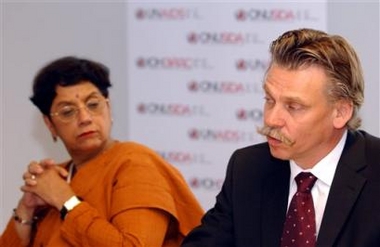Odd News
UNAIDS head: World is losing HIV fight
(AP)
Updated: 2006-05-30 22:40
 |
Large Medium Small |
The world continues to lose an ugly battle to HIV/AIDS that shows no sign of letting up after 25 million people have died a quarter-century into the epidemic, the head of the U.N.'s HIV/AIDS joint program said.
 Director of Policy, Evidence and Partnerships of UNAIDS Dr. Purnima Mane, left, listens while Manager for Epidemic and Impact Monitoring of UNAIDS Dr. Peter Ghys, right, talks to the media during a press conference concerning the ' Global Summary of the HIV and AIDS Epidemic, 2005' organized by the UNAIDS organisation in the Residence Palace in Brussels, Tuesday May 30, 2006. [AP] |
"I think we will see a further globalization of the epidemic spreading to every single corner of the planet,"
UNAIDS head Peter Piot told The Associated Press in a telephone interview from Geneva.
UNAIDS on Tuesday was scheduled to launch a 630-page report that takes stock of where the world currently stands with nearly 40 million people living with HIV/AIDS. It documents countries' progress and failures, and projects what must happen to keep some regions from experiencing disaster. The report was set to be released a day ahead of a High Level Meeting on AIDS in New York, a week prior to the 25th anniversary of the first documented AIDS cases on June 5, 1981.
"It won't go away one fine day, and then we wake up and say, 'Oh, AIDS is gone,'" Piot said. "I think we have to start thinking about looking at the next generations. There's an increasing diversity in how the epidemic looks."
Piot said that there is still time to stop it from worsening, but action is needed now on a number of fronts.
"Ultimately, it depends on how the leadership reacts, how the international community will continue to respond and how ready communities are to face the problem," Piot said. "Intervention is very low ... for many critical populations in many countries. We need to really intensify the response to AIDS."
Piot said the picture is not hopeless, with examples of progress in nearly every part of the world. He said Thailand and Uganda were two of the only previous examples where exploding epidemics were curbed, but a handful of other countries, including Kenya and Zimbabwe, are also starting to show promise.
Epidemics are diversifying, Piot said, with some driven by unprotected sex, others by dirty needles and some a combination of the two overlapping each other. Those trends must be identified and targeted.
Currently, about 1.3 million people in poor countries have access to antiretroviral treatment, but about 80 percent still are not receiving drugs.
Sub-Saharan Africa continues to be the epicenter of the virus, Piot said. The overall percentage of adults infected in some of the hardest-hit countries continues to climb, with several rates reaching double digits.






